My most recent “At the Airport” column for USA TODAY explores the “Experience Hub” at Dallas-Fort Worth International Airport. Take a look and let us know if you think this model can make a difference in passenger happiness at other airports.
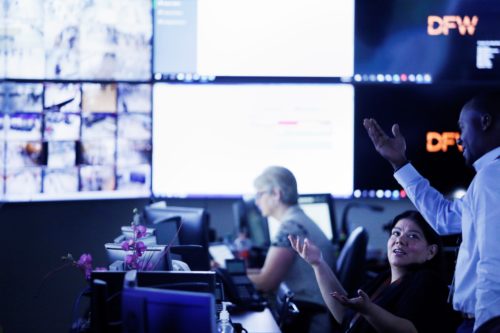
Like most airports, Dallas-Forth International has an operations center to monitor everything happening out on the airfield.
But for the past two few years DFW has been beefing up another type of behind-the-scenes center.
This one is called the Experience Hub and its role is to keep watch over everything happening inside the terminals, to respond as swiftly as possible to any sort of passenger issue and to solve problems before they happen.
Every airport will tell you it has people and departments to do all that. However, DFW officials believe their customer experience hub is a unique and more effective way to serve its more than 69 million passengers in part because it has centralized many functions that were previously spread out across departments and locations.
“Everybody here has responsibility driven by making the customer experience the best it can be,” said Julio Badin, DFW’s Vice President of Customer Service during a recent tour of the windowless, 7,000-square foot room in Terminal D that houses representatives from just about every customer-facing agency or department at the airport and dozens of monitors streaming data and live terminal feeds.
“This group is focused on all the things that touch the customer from the experience perspective,” said Badin, pointing out staff checking on everything from the weather and airline load factors to TSA lines, baggage room operations, custodial schedules, restroom maintenance needs and mentions of DFW on social media.
The hub, located on the non-secure side of the airport, in Terminal D, is staffed 24-hours a day and has a conference table in the center and low-lit work stations (to avoid monitor glare) for about 20 people around the perimeter.
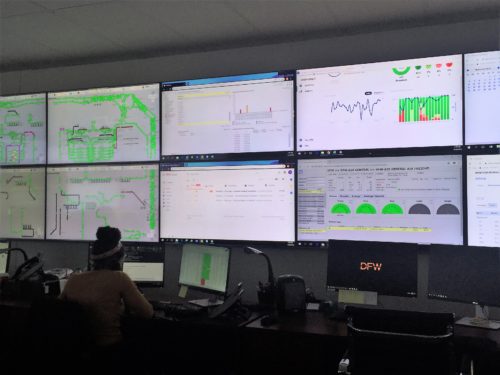
Two officers from the Transportation Security Administration’s planning department are chatting about what they see on the monitors at their work station. Their job: to study projected passenger numbers from the airlines, observe the wait times at the airport’s various security checkpoints and decide how and when to open additional lanes, move staff around and send in teams of bomb sniffing canines with their handlers to help speed things up.
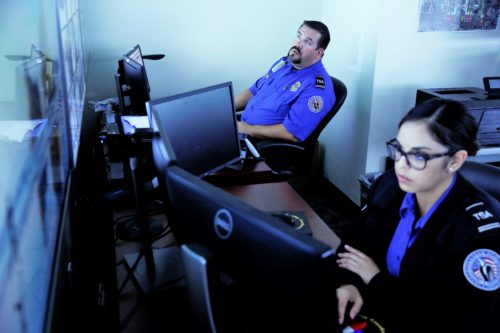
“The planning team is the guts behind how well the TSA checkpoints work,” said DFW’s Badin, who was pleased that TSA accepted the airport’s invitation to locate this team here.
Sitting nearby the TSA planners are customer care specialists who spend their days answering passenger questions, solving problems for travelers and monitoring and responding to social media messages or mentions.
“People call wanting to know if their car will be towed if their flight gets back late. They want to know where they can get a mimosa at 8 a.m. And, of course, we get lots of calls from people who need help finding lost items,” said Clara Meyer, an Experience Hub Specialist whose shift starts 4:30 a.m.
“We once got a call about a man flying in on a flight from India. He didn’t know that his travel agent had put him on a flight to Dallas instead of [Washington] Dulles and his daughter called us asking for help,” said Meyer, “We sent someone to find him to explain what happened and had them stay with him until he got onto a flight to Dulles. We also helped him on the way home.”
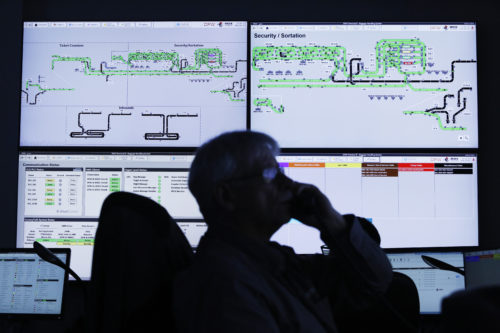
The computer screens at the work station next to Meyers are filled with live streams of messages tagged with #DFW on Twitter, Facebook, Instagram and other social media streams.
A hub staff member responds in real time to just about anything that pops up on social media relating to DFW customer service. Sometimes it’s a “Welcome to DFW,” or “Sorry your flight is late,” message. But often the response is a tweet filled with specific information a customer has requested, such as a list of airport restaurants open before 5 a.m. or a shop that might sell a replacement for a left-behind hair straightener.
And because the social media monitoring desk is in DFW’s Experience Hub, if there’s a tweet from, say, a frustrated mom who’s run out of diapers during a flight delay, there’s someone at the next desk who can call or text one of the airport customer experience specialists (ACES) out in the terminals and have them bring supplies over.
Make a playlist and follow it
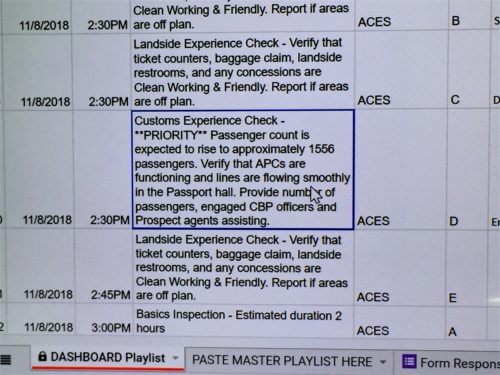
Back in the hub, each day begins with the building of “playlists,” said DFW Experience Hub Manager Ricky Griffin, “We look at expected passenger loads, weather, and other factors so we can give the ACEs a detailed list of tasks they should complete and check off in the terminals that day.”
To predict the day’s passenger flows and identify areas that might need extra attention, Griffin’s team looks at what TSA has planned for staffing and holds conference calls with American Airlines (which has a main hub at DFW) and other departments at the airport to find out what they may be expecting that day.
“Then we draft an email that goes out to our team to let them know what’s happening,” said Griffin. As the day progresses, everyone in the hub continues monitoring and watching out for everything from such storms in the area to baggage hiccups, unattended luggage, fire alarms, and anything that might cause a glitch in the terminals.
The time, energy and resources DFW is putting into enhancing the customer experience for passengers seems to be paying off.
The airport has won some major customer service awards and in the past year other airports keen to raise their level of customer service, including Denver, Minneapolis-St. Paul and Seattle-Tacoma International and a few international airports have sent teams out to see DFW’s Experience Hub in action.
Thanks for visiting Stuck at the Airport. Subscribe to get daily travel tidbits. And follow me on Twitter at @hbaskas and Instagram.